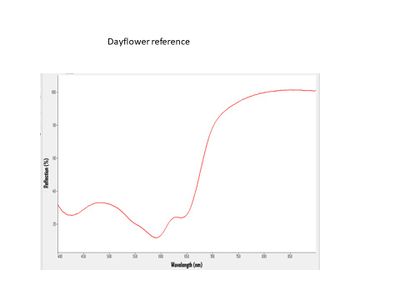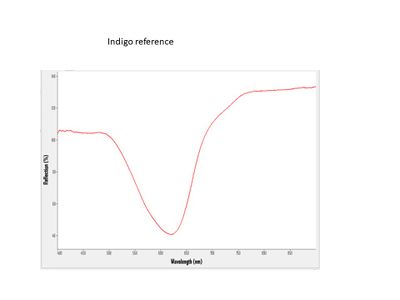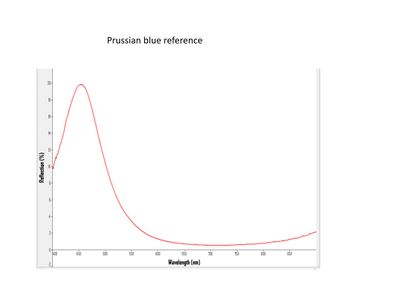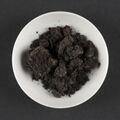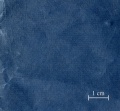Difference between revisions of "Category:Indigo: Ukiyo-e colorant"
| (10 intermediate revisions by the same user not shown) | |||
| Line 1: | Line 1: | ||
| − | [[File:SC222268.jpg|right| | + | [[File:SC222268.jpg|right|300px|link=Eisen,_The_Song_Evening_Mist_at_Asama_Peak,_on_Scrap-paper_Fabric_with_an_Itchû-bushi_Libretto,_from_the_series_A_Modern_Pine_Needle_Collection,_11.17878|The Song Evening Mist at Asama Peak by Keisai Eisen]] |
| − | <font size="3">'''[[Indigo]]'''</font> 藍(''ai''): A natural dark blue dye obtained from ''Indigofera tinctoria'' plants native to India, Java, Peru, and other tropical areas. The use of indigo was first mentioned in Indian manuscripts in the 4th century BCE. In Japan, indigo was introduced from China in the 6th century. The dye is obtained from an indigo plant native to Asia, ''Persicaria tinctoria'' 蓼藍 | + | <font size="3">'''[[Indigo]]'''</font> 藍 (''ai''): A natural dark blue dye obtained from ''Indigofera tinctoria'' plants native to India, Java, Peru, and other tropical areas. The use of indigo was first mentioned in Indian manuscripts in the 4th century BCE. In Japan, indigo was introduced from China in the 6th century CE. The dye is obtained from an indigo plant native to Asia, ''Persicaria tinctoria'' (蓼藍 ''tadeai''). The colorant can also be extracted from indigo dyed cloth or fibers according to Hokusai's illustrated treatise, ''Ehon saishikitsū'' (画本彩色通). Indian indigo began to be imported around the end of the Edo period (1603–1868). |
Indigo and [[:Category:Dayflower: Ukiyo-e colorant|dayflower]] are the two blues used in Japanese woodblock prints until [[:Category:Prussian Blue: Ukiyo-e colorant|Prussian blue]] enters the palette in the 1830s. Indigo appears most frequently from the 1740s onwards as a color mixed with orpiment to produce a variety of greens. As a single colorant, it appears as a comparatively dull blue color. Due to its poor tinting strength, a relatively large amount needs to be used during printing in order to obtain a good saturation of this color. Its texture is somewhat coarse which makes it difficult to execute graduated hues from dark to light. | Indigo and [[:Category:Dayflower: Ukiyo-e colorant|dayflower]] are the two blues used in Japanese woodblock prints until [[:Category:Prussian Blue: Ukiyo-e colorant|Prussian blue]] enters the palette in the 1830s. Indigo appears most frequently from the 1740s onwards as a color mixed with orpiment to produce a variety of greens. As a single colorant, it appears as a comparatively dull blue color. Due to its poor tinting strength, a relatively large amount needs to be used during printing in order to obtain a good saturation of this color. Its texture is somewhat coarse which makes it difficult to execute graduated hues from dark to light. | ||
| Line 7: | Line 7: | ||
[[:Category:Indigo/Orpiment: Ukiyo-e colorant|Indigo and orpiment]] are mixed or overprinted to create a green. This mixture is the most commonly seen combination to create a green. | [[:Category:Indigo/Orpiment: Ukiyo-e colorant|Indigo and orpiment]] are mixed or overprinted to create a green. This mixture is the most commonly seen combination to create a green. | ||
| − | '''For additional information see:''' [[Indigo]], Uemura Dye Archive: [[Sukumo-Ai_(Indigo)_-_left_(272_L)|Indigo 272]], [[Tadeai_(Japanese_indigo)_-_right_(274_R)|274]], [[Sukumo-Ai_(Indigo)_-_-|275]] | + | '''For additional information see:''' [[Indigo]], Uemura Dye Archive: [[Sukumo-Ai_(Indigo)_-_left_(272_L)|Indigo 272]], [[Tadeai_(Japanese_indigo)_-_right_(274_R)|274]], [[Sukumo-Ai_(Indigo)_-_-|275]], [https://powo.science.kew.org/taxon/urn:lsid:ipni.org:names:60455325-2 ''Persicaria tinctoria'' (Kew)] |
| + | <br> | ||
<br> | <br> | ||
| Line 54: | Line 55: | ||
<gallery> | <gallery> | ||
File:Persicaria tinctoria.jpg|''Persicaria tinctoria'', <small>by Tokushima Prefectural Souvenir and Tourism Plaza</small>|link=https://tokushima-bussan.com/crafts/awa-ai/ | File:Persicaria tinctoria.jpg|''Persicaria tinctoria'', <small>by Tokushima Prefectural Souvenir and Tourism Plaza</small>|link=https://tokushima-bussan.com/crafts/awa-ai/ | ||
| − | File:indigo tinctoria t.jpg| | + | File:indigo tinctoria t.jpg|''Indigofera tinctoria'' |
Indigo sticks.jpg|Indigo sticks, <small>by Takeo City Library</small>|link=https://www.city.takeo.lg.jp/rekisi/kikaku/2012/ao/ao.html | Indigo sticks.jpg|Indigo sticks, <small>by Takeo City Library</small>|link=https://www.city.takeo.lg.jp/rekisi/kikaku/2012/ao/ao.html | ||
File:indigo_piece_1.jpg|Indigo piece (''Indigofera tinctoria'') | File:indigo_piece_1.jpg|Indigo piece (''Indigofera tinctoria'') | ||
| Line 61: | Line 62: | ||
File:dyed indigo.jpg|Paper dyed with indigo | File:dyed indigo.jpg|Paper dyed with indigo | ||
File:indigo_50X2.jpg|Paper dyed with indigo at 50x | File:indigo_50X2.jpg|Paper dyed with indigo at 50x | ||
| − | File:46_Indigo_blue_500X.jpg|Indigo blue | + | File:46_Indigo_blue_500X.jpg|Indigo blue at 500x |
File:Printed indigo1-cropped.jpg|Printed Indigo | File:Printed indigo1-cropped.jpg|Printed Indigo | ||
File:Printed indigo2-cropped.jpg|Printed Indigo | File:Printed indigo2-cropped.jpg|Printed Indigo | ||
| + | File:NMAH-AHB2017q005556.jpg|Indigo paste, <small>by National Museum of Natural History</small>|link=https://americanhistory.si.edu/collections/nmah_1323755 | ||
File:20463404.jpg|Indigo (audio), <small>by Harvard Art Museums</small>|link=https://harvardartmuseums.org/tour/660/slide/11150 | File:20463404.jpg|Indigo (audio), <small>by Harvard Art Museums</small>|link=https://harvardartmuseums.org/tour/660/slide/11150 | ||
| − | File:Wi9zwOHzt1g-SD.jpg|Ai-Tokushima:The story of Japan blue ( | + | File:Wi9zwOHzt1g-SD.jpg|Ai-Tokushima:The story of Japan blue (video), <small>by Tokushima prefecture channel</small>|link=https://www.youtube.com/watch?v=wi9zwOHzt1g&t=30s |
File:9 9WAv57VKw-SD.jpg|Awa indigo and its production method (video), <small>by jrtservice623</small>|link=https://www.youtube.com/watch?v=9_9WAv57VKw | File:9 9WAv57VKw-SD.jpg|Awa indigo and its production method (video), <small>by jrtservice623</small>|link=https://www.youtube.com/watch?v=9_9WAv57VKw | ||
File:BP75xw1IptY-HQ.jpg|Indigo Building (video), <small>by Yamatokoriyama City Tourism Association</small>|link=https://www.youtube.com/watch?v=BP75xw1IptY | File:BP75xw1IptY-HQ.jpg|Indigo Building (video), <small>by Yamatokoriyama City Tourism Association</small>|link=https://www.youtube.com/watch?v=BP75xw1IptY | ||
File:UEMcjmyjoOY-SD.jpg|Indigo dye extraction (video), <small>by kmaexports</small>|link=https://www.youtube.com/watch?v=UEMcjmyjoOY | File:UEMcjmyjoOY-SD.jpg|Indigo dye extraction (video), <small>by kmaexports</small>|link=https://www.youtube.com/watch?v=UEMcjmyjoOY | ||
</gallery> | </gallery> | ||
| − | + | <!--Add 千種の花、vol2 p16--> | |
| − | Add 千種の花、vol2 p16 | ||
==List of Prints == | ==List of Prints == | ||
Below is a list of prints where indigo was detected. | Below is a list of prints where indigo was detected. | ||
Latest revision as of 01:06, 13 April 2024
Indigo 藍 (ai): A natural dark blue dye obtained from Indigofera tinctoria plants native to India, Java, Peru, and other tropical areas. The use of indigo was first mentioned in Indian manuscripts in the 4th century BCE. In Japan, indigo was introduced from China in the 6th century CE. The dye is obtained from an indigo plant native to Asia, Persicaria tinctoria (蓼藍 tadeai). The colorant can also be extracted from indigo dyed cloth or fibers according to Hokusai's illustrated treatise, Ehon saishikitsū (画本彩色通). Indian indigo began to be imported around the end of the Edo period (1603–1868).
Indigo and dayflower are the two blues used in Japanese woodblock prints until Prussian blue enters the palette in the 1830s. Indigo appears most frequently from the 1740s onwards as a color mixed with orpiment to produce a variety of greens. As a single colorant, it appears as a comparatively dull blue color. Due to its poor tinting strength, a relatively large amount needs to be used during printing in order to obtain a good saturation of this color. Its texture is somewhat coarse which makes it difficult to execute graduated hues from dark to light.
Indigo and orpiment are mixed or overprinted to create a green. This mixture is the most commonly seen combination to create a green.
For additional information see: Indigo, Uemura Dye Archive: Indigo 272, 274, 275, Persicaria tinctoria (Kew)
Examples of Indigo in Ukiyo-e Prints

|

|

|

|

|
Analysis
Fiber optic reflectance spectroscopy (FORS) can easily identify the three blues: dayflower, indigo, and Prussian blue.
Images of Indigo
List of Prints
Below is a list of prints where indigo was detected.
Pages in category "Indigo: Ukiyo-e colorant"
The following 13 pages are in this category, out of 13 total.
E
H
S
T
- TEST-Utamaro I, Women Overnight Guests, a Triptych, 21.6328-30
- TEST-Utamaro I, Women Overnight Guests, left panel of triptych, 21.6328
- Toyokuni, Actor Arashi Kitsusaburô I as the Monkey Trainer Yojirô, in the Horikawa Scene of the Play Oshun and Denbei, 11.30331
- Toyonobu, Rain in the Fifth Month, 11.19048
- Toyonobu, Young Couple Burning Maple Leaves to Heat Sake, 11.19676


